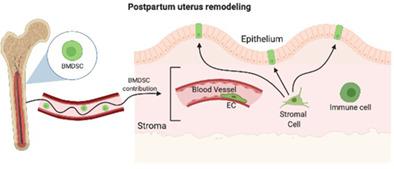当前位置:
X-MOL 学术
›
STEM CELLS
›
论文详情
Our official English website, www.x-mol.net, welcomes your feedback! (Note: you will need to create a separate account there.)
Bone marrow-derived progenitor cells contribute to remodeling of the postpartum uterus
STEM CELLS ( IF 5.2 ) Pub Date : 2021-07-05 , DOI: 10.1002/stem.3431 Reshef Tal 1 , Jacqueline Kisa 1 , Nafeesa Abuwala 1 , Harvey J Kliman 1 , Shafiq Shaikh 1 , Alice Y Chen 1 , Fang Lyu 1 , Hugh S Taylor 1
STEM CELLS ( IF 5.2 ) Pub Date : 2021-07-05 , DOI: 10.1002/stem.3431 Reshef Tal 1 , Jacqueline Kisa 1 , Nafeesa Abuwala 1 , Harvey J Kliman 1 , Shafiq Shaikh 1 , Alice Y Chen 1 , Fang Lyu 1 , Hugh S Taylor 1
Affiliation

|
Endometrial stem/progenitor cells play a role in postpartum uterine tissue regeneration, but the underlying mechanisms are poorly understood. While circulating bone marrow (BM)-derived cells (BMDCs) contribute to nonhematopoietic endometrial cells, the contribution of BMDCs to postpartum uterus remodeling is unknown. We investigated the contribution of BMDCs to the postpartum uterus using 5-fluorouracil-based nongonadotoxic BM transplant from green fluorescent protein (GFP) donors into wild-type C57BL/6J female mice. Flow cytometry showed an influx of GFP+ cells to the uterus immediately postpartum accounting for 28.7% of total uterine cells, followed by a rapid decrease to prepregnancy levels. The majority of uterine GFP+ cells were CD45+ leukocytes, and the proportion of nonhematopoietic CD45−GFP+ cells peaked on postpartum day (PPD) 1 (17.5%). Immunofluorescence colocalization of GFP with CD45 pan-leukocyte and F4/80 macrophage markers corroborated these findings. GFP+ cells were found mostly in subepithelial stromal location. Importantly, GFP+ cytokeratin-positive epithelial cells were found within the luminal epithelium exclusively on PPD1, demonstrating direct contribution to postpartum re-epithelialization. A subset (3.2%) of GFP+ cells were CD31+CD45− endothelial cells, and found integrated within blood vessel endothelium. Notably, BM-derived GFP+ cells demonstrated preferential proliferation (PCNA+) and apoptosis (TUNEL+) on PPD1 vs resident GFP− cells, suggesting an active role for BMDCs in rapid tissue turnover. Moreover, GFP+ cells gradually acquired cell senescence together with decreased proliferation throughout the postpartum. In conclusion, BM-derived progenitors were found to have a novel nonhematopoietic cellular contribution to postpartum uterus remodeling. This contribution may have an important functional role in physiological as well as pathological postpartum endometrial regeneration.
中文翻译:

骨髓来源的祖细胞有助于产后子宫的重塑
子宫内膜干/祖细胞在产后子宫组织再生中发挥作用,但其潜在机制知之甚少。虽然循环骨髓 (BM) 衍生细胞 (BMDCs) 有助于非造血子宫内膜细胞,但 BMDCs 对产后子宫重塑的贡献尚不清楚。我们使用基于 5-氟尿嘧啶的非性腺毒性 BM 将绿色荧光蛋白 (GFP) 供体移植到野生型 C57BL/6J 雌性小鼠中,研究了 BMDCs 对产后子宫的贡献。流式细胞术显示 GFP+ 细胞在产后立即流入子宫,占子宫总细胞的 28.7%,随后迅速下降至孕前水平。大多数子宫 GFP+ 细胞是 CD45+ 白细胞,非造血 CD45-GFP+ 细胞的比例在产后第 1 天 (PPD) 达到峰值 (17.5%)。GFP 与 CD45 泛白细胞和 F4/80 巨噬细胞标志物的免疫荧光共定位证实了这些发现。GFP+细胞主要位于上皮下基质位置。重要的是,GFP+ 细胞角蛋白阳性上皮细胞仅在 PPD1 上的腔上皮内被发现,这表明对产后再上皮化有直接贡献。GFP+ 细胞的一个子集(3.2%)是 CD31+CD45- 内皮细胞,发现整合在血管内皮细胞中。值得注意的是,BM 衍生的 GFP+ 细胞在 PPD1 与常驻 GFP-细胞上表现出优先增殖 (PCNA+) 和凋亡 (TUNEL+),这表明 BMDCs 在快速组织更新中发挥积极作用。此外,GFP+ 细胞逐渐获得细胞衰老以及整个产后增殖减少。综上所述,BM 衍生的祖细胞被发现对产后子宫重塑具有新的非造血细胞贡献。这种贡献可能在生理和病理产后子宫内膜再生中具有重要的功能作用。
更新日期:2021-07-05
中文翻译:

骨髓来源的祖细胞有助于产后子宫的重塑
子宫内膜干/祖细胞在产后子宫组织再生中发挥作用,但其潜在机制知之甚少。虽然循环骨髓 (BM) 衍生细胞 (BMDCs) 有助于非造血子宫内膜细胞,但 BMDCs 对产后子宫重塑的贡献尚不清楚。我们使用基于 5-氟尿嘧啶的非性腺毒性 BM 将绿色荧光蛋白 (GFP) 供体移植到野生型 C57BL/6J 雌性小鼠中,研究了 BMDCs 对产后子宫的贡献。流式细胞术显示 GFP+ 细胞在产后立即流入子宫,占子宫总细胞的 28.7%,随后迅速下降至孕前水平。大多数子宫 GFP+ 细胞是 CD45+ 白细胞,非造血 CD45-GFP+ 细胞的比例在产后第 1 天 (PPD) 达到峰值 (17.5%)。GFP 与 CD45 泛白细胞和 F4/80 巨噬细胞标志物的免疫荧光共定位证实了这些发现。GFP+细胞主要位于上皮下基质位置。重要的是,GFP+ 细胞角蛋白阳性上皮细胞仅在 PPD1 上的腔上皮内被发现,这表明对产后再上皮化有直接贡献。GFP+ 细胞的一个子集(3.2%)是 CD31+CD45- 内皮细胞,发现整合在血管内皮细胞中。值得注意的是,BM 衍生的 GFP+ 细胞在 PPD1 与常驻 GFP-细胞上表现出优先增殖 (PCNA+) 和凋亡 (TUNEL+),这表明 BMDCs 在快速组织更新中发挥积极作用。此外,GFP+ 细胞逐渐获得细胞衰老以及整个产后增殖减少。综上所述,BM 衍生的祖细胞被发现对产后子宫重塑具有新的非造血细胞贡献。这种贡献可能在生理和病理产后子宫内膜再生中具有重要的功能作用。



























 京公网安备 11010802027423号
京公网安备 11010802027423号